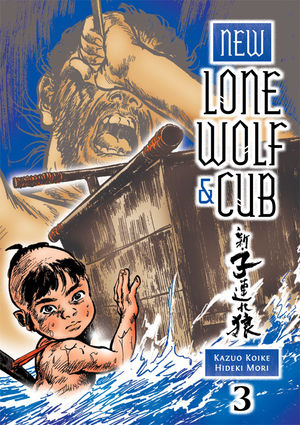Editing New Lone Wolf and Cub affords me the opportunity to compare the sequel to the original, and see both the elements they share, and where they diverge. I find the two respective key protagonists, Ogami Itt? of Lone Wolf and Cub, and New Lone Wolf’s T?g? Shigekata, fascinating character contrasts. Both are warriors of spectacular skill, iron will, and unshakeable devotion to honor and to young Daigoro. And yet they are two very different people.
Ogami was a family man. He was court executioner in Edo, the capital of the shogunate, the center of power in feudal Japan. He was betrayed by the system he had so loyally served, accused falsely of the one crime he would never commit: disloyalty. While vengeance for his wife’s murder and the vindication of his family name were certainly part of what drove him forward on “the road to hell,” the desire to expose and purge the evil within the system was equal motivation, the conclusive proof of his adherence to loyalty and honor.
T?g? is simpler in many ways. He had no wife or child of his own; he is a retainer serving a local lord, far from the capital in Satsuma, a province famous in Japanese history for its independence and agitation. He hasn’t been forced out of the system as Ogami had been. He is still leading a life of service and honor. Yet exploring what honor truly demands is much of what New Lone and Cub is about. Ogami didn’t choose to change his life and could never go back to it—his only choice was either to commit seppuku, or to start down his assassin’s road. T?g?, by contrast, can still make choices about his life—and soon he must.
I don’t want to get into spoilers here, since a lot of what I’m talking about really starts to rev up in Volume 3, out this week, but whereas the Lone Wolf seemed to follow a clear and unbending road to an inevitable reckoning, the new Lone Wolf’s path is murky, twisted, and overgrown—exploring the limitations of loyalty in the face of even higher truths. A difficult journey to be sure, but well worth the effort, especially for the reader!
—Chris Warner
Senior Editor
 Editing New Lone Wolf and Cub affords me the opportunity to compare the sequel to the original, and see both the elements they share, and where they diverge. I find the two respective key protagonists, Ogami Itto of Lone Wolf and Cub, and New Lone Wolf's Togo Shigekata, fascinating character contrasts. Both are warriors of spectacular skill, iron will, and unshakeable devotion to honor and to young Daigoro. And yet they are two very different people.
Editing New Lone Wolf and Cub affords me the opportunity to compare the sequel to the original, and see both the elements they share, and where they diverge. I find the two respective key protagonists, Ogami Itto of Lone Wolf and Cub, and New Lone Wolf's Togo Shigekata, fascinating character contrasts. Both are warriors of spectacular skill, iron will, and unshakeable devotion to honor and to young Daigoro. And yet they are two very different people.
Ogami was a family man. He was court executioner in Edo, the capital of the shogunate, the center of power in feudal Japan. He was betrayed by the system he had so loyally served, accused falsely of the one crime he would never commit: disloyalty. While vengeance for his wife’s murder and the vindication of his family name were certainly part of what drove him forward on “the road to hell,” the desire to expose and purge the evil within the system was equal motivation, the conclusive proof of his adherence to loyalty and honor.
Togo is simpler in many ways. He had no wife or child of his own; he is a retainer serving a local lord, far from the capital in Satsuma, a province famous in Japanese history for its independence and agitation. He hasn’t been forced out of the system as Ogami had been. He is still leading a life of service and honor. Yet exploring what honor truly demands is much of what New Lone and Cub is about. Ogami didn’t choose to change his life and could never go back to it—his only choice was either to commit seppuku, or to start down his assassin’s road. Togo, by contrast, can still make choices about his life—and soon he must.
I don’t want to get into spoilers here, since a lot of what I’m talking about really starts to rev up in Volume 3, out this week, but whereas the Lone Wolf seemed to follow a clear and unbending road to an inevitable reckoning, the new Lone Wolf’s path is murky, twisted, and overgrown—exploring the limitations of loyalty in the face of even higher truths. A difficult journey to be sure, but well worth the effort, especially for the reader!
—Chris Warner
Senior Editor